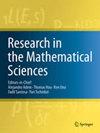双螺旋结的交叉数
IF 1.2
3区 数学
Q1 MATHEMATICS
引用次数: 0
摘要
我们确定了(素数)两性结的交叉数。这个问题可以追溯到十九世纪末泰特和利特尔提出的绳结表的起源。该证明是对琼斯多项式边系数的半完备性公式的最实质性应用。本文章由计算机程序翻译,如有差异,请以英文原文为准。

The crossing numbers of amphicheiral knots
We determine the crossing numbers of (prime) amphicheiral knots. This problem dates back to the origin of knot tables by Tait and Little at the end of the nineteenth century. The proof is the most substantial application of the semiadequacy formulas for the edge coefficients of the Jones polynomial.
求助全文
通过发布文献求助,成功后即可免费获取论文全文。
去求助
来源期刊

Research in the Mathematical Sciences
Mathematics-Computational Mathematics
CiteScore
2.00
自引率
8.30%
发文量
58
期刊介绍:
Research in the Mathematical Sciences is an international, peer-reviewed hybrid journal covering the full scope of Theoretical Mathematics, Applied Mathematics, and Theoretical Computer Science. The Mission of the Journal is to publish high-quality original articles that make a significant contribution to the research areas of both theoretical and applied mathematics and theoretical computer science.
This journal is an efficient enterprise where the editors play a central role in soliciting the best research papers, and where editorial decisions are reached in a timely fashion. Research in the Mathematical Sciences does not have a length restriction and encourages the submission of longer articles in which more complex and detailed analysis and proofing of theorems is required. It also publishes shorter research communications (Letters) covering nascent research in some of the hottest areas of mathematical research. This journal will publish the highest quality papers in all of the traditional areas of applied and theoretical areas of mathematics and computer science, and it will actively seek to publish seminal papers in the most emerging and interdisciplinary areas in all of the mathematical sciences. Research in the Mathematical Sciences wishes to lead the way by promoting the highest quality research of this type.
 求助内容:
求助内容: 应助结果提醒方式:
应助结果提醒方式:


